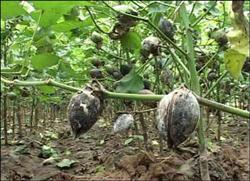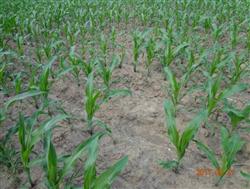How to manage and prevent the premature senescence of cotton in the later stage?

How to manage and prevent the premature senescence of cotton in the later stage? Please introduce the methods to prevent and control the premature senescence of cotton in the later stage, you can refer to the following methods for management: first, fertilizer and water management should re-apply flower and boll fertilizer according to cotton plant situation, climate and soil conditions, such as insufficient flower and boll fertilizer, and then apply top fertilizer. After entering the middle of August, if the maximum water holding capacity in the field is less than 60%, and when it is less than 55% in the first ten days of September, it is necessary to water in time and promote fertilizer with water to ensure that the fertilizer effect is brought into full play in time. If the premature senescence of cotton is caused by the lack of potassium in the soil, the application of potassium sulfate or potassium chloride should be increased by 5kg of potassium sulfate or potassium chloride at the seedling stage while applying base fertilizer. When applying fertilizer, we must plough more than 20 centimeters, apply fertilizer to the bottom of the plow, apply fertilizer deeply, promote the root system, reduce fertilizer loss, and improve fertilizer use efficiency. Water should be watered in case of drought during flowering and boll setting period, ditch boxes should be carefully cleaned to prevent further water stains, and waterlogging should be drained in time when waterlogging occurs. Second, rational control should be combined with climate, soil fertility and appearance, and comprehensively consider the chemical control time and the amount of strengthening element, which is the most important thing in order to prevent the premature senescence of the plant. Generally, cotton Zhuangtiling and other regulators were sprayed several times in 8-leaf stage, bud stage, early flowering stage, full flowering stage and after topping, in order to achieve the purpose of reasonable regulation. Third, extra-root topdressing after August, cotton fields deficient in phosphorus and potassium can be sprayed with 300-500 times of potassium dihydrogen phosphate every 10-15 days, 60,80kg per mu. For nitrogen deficient cotton field, 200 times urea solution can be sprayed. Topdressing outside the root can be sprayed all day in cloudy days and in sunny days in the evening to avoid burns to leaves. Fourth, after breaking the binding rain, for the cotton fields that are not closed, especially in the hilly areas, the soil should be loosened in time to break the consolidation. Do not loosen the soil too deep, so as not to damage the root system and destroy the soil. It can also be sprayed with soil conditioner "no deep tillage". Spraying "no-deep tillage" can break the consolidation, loosen the soil, improve the soil structure, give full play to the fertilizer effect, promote the normal growth of the root system, and improve the root absorption capacity. The method of spraying "no deep ploughing": 200 ml of medicine per mu mixed with 50 kg of water, evenly sprayed on the soil line. Fifth, topping pruning first of all, timely fine pruning, removal of invalid buds, and all buds after the Beginning of Autumn or flowers after White Dew should be removed to reduce consumption. Secondly, there should be fewer fruit nodes for the lower fruit branches, one for the first and second fruit branches, and two for the third and fourth fruit branches. This method can save organic nutrients and prevent cotton from premature senescence in the later stage. 6. the functional period of normal leaves is generally about 8 weeks, but due to the influence of pests such as cotton bollworm, blind Toona sinensis, red spider and diseases such as Fusarium wilt, Verticillium wilt and red leaf stem blight, the leaves are damaged or shedding, which reduces the function of leaves and accelerates premature senescence. Therefore, it is necessary to control insect pests, reduce diseases and prolong leaf function. In the early stage of Verticillium wilt, 1000 times of carbendazim can be used to irrigate roots (0.5kg / plant), or a mixture of fulvic acid and new high lipid membrane can be used to control the disease. Click to get more cotton planting technology click to get more food crop planting technology
- Prev

How to prevent cotton boll rot with high temperature and humidity?
How to prevent cotton boll rot with high temperature and humidity? Please introduce the methods of cotton boll rot prevention and control with reference to the following methods: 1. Rational fertilization: increase the application of organic fertilizer and phosphorus and potassium fertilizer, and apply appropriate amount of nitrogen fertilizer to prevent cotton plant growth, reduce cotton field closure, and improve ventilation and light transmission. 2. Timely drainage: for low-lying terrain.
- Next

What are the reasons for the lack of corn seedlings?
What are the reasons for the lack of corn seedlings? Please give us an introduction and the reasons for the lack of maize seedlings caused by the prevention and control methods are as follows: do not soak the seeds to accelerate the germination of corn seed coating agent dissolved in water, it will not only fail, but also inhibit seed germination. Do not sow too deep summer corn. The suitable sowing depth is 3-5 cm. If the sowing is too deep, the ground temperature drops.
Related
- The first cup of black tea in spring, the flavor and history of tea gardens in Kenya, Africa
- The computer can not only choose potatoes, but also grow tea rice. AI will grow winter oolong tea champion.
- It is not only the inflated tea bitten by insects, but also engraved with the four seasons tea in Beipu.
- The Oriental Beauty Tea Festival in Zhuxian County takes the stage at the weekend to experience the plus-size feast of oil tea.
- & quot; Oriental Beauty Tea & Exploration of Emei in Hsinchu, the hometown of quot;
- The new variety of strawberry "Tainong 1" dessert is the first choice with mellow aroma. Crimson gorgeous
- History of Tea in Taiwan: from Wild Inner Mountain to Export Tea Garden
- Two types of Taiwan Oriental Beauty Black Tea won the British three-Star Award for Childhood Tea Xiang Zhang Jiaqi changed from pilot to champion tea maker.
- Banana species and varieties: the planting history of Taiwan Xianren banana and dwarf banana is long, is banana disease resistant?
- Coffee planting Technology: Qianjie Coffee from Seedling to harvesting

